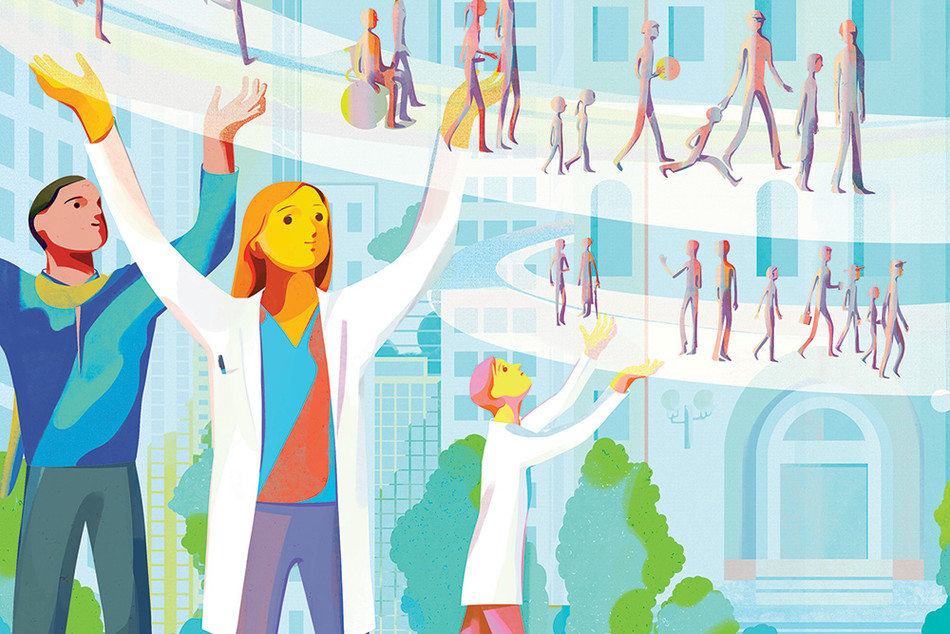In late 1918, with influenza surging in New York City, Joseph De Lamar, a Dutch-born mining mogul who had lived on Madison Avenue, left $3 million to Columbia’s College of Physicians and Surgeons to study the causes and prevention of human disease. The Spanish flu, which would kill some 675,000 Americans, was the latest public-health emergency in a city that had seen outbreaks of cholera, malaria, typhoid fever, yellow fever, polio, smallpox, and tuberculosis, as well as the effects of poor sanitation, crowded tenements, and hazardous workplaces.
De Lamar’s bequest helped realize an institutional vision that dated to 1908, when Norman Edward Ditman 1900GSAS, an instructor in pathology at the College of Physicians and Surgeons, called for a school of public health that would focus on preventive medicine. In 1922, Columbia’s De Lamar Institute of Public Health, led by former New York City health commissioner Haven Emerson 1899VPS, opened on West 59th Street, in a single classroom with a single student. The institute, which was part of the College of Physicians and Surgeons, grew and became a separate school within the University in 1945, and was renamed in 1998 in recognition of a $33 million gift from businessman and philanthropist Joseph L. Mailman. Over the years, the school emerged as a leader in the study of maternal, reproductive, and childhood health, occupational safety, HIV treatment, environmental exposures, obesity, healthy longevity, infectious-disease identification and care, and the use of biostatistics to better understand disease.
Today the school has 1,300 graduate students, 378 faculty, more than 17,000 alumni, and $250 million in sponsored research for projects in more than a hundred countries. This past September, New York City mayor Bill de Blasio ’87SIPA announced that Columbia and the Mailman School would lead the city’s new Pandemic Response Institute, to help the city prepare for future pandemics.
With public health in the spotlight like never before, Linda P. Fried, an epidemiologist and geriatrician who has been dean since 2008, is leading the school into a future of enormous challenges, including climate change, emerging viruses, food-system failures, and an aging population. “Some health problems can be solved one person at a time, but most of health involves what we have to do together,” says Fried. “These problems are going to deeply jeopardize our health in coming years unless we find solutions and understand that when we protect each other’s health we protect our own.”
Fried notes that while 70 percent of any population’s health status depends on factors like air and water quality, food safety, and prevalence of infectious diseases, the US spends 97 percent of its health dollars on individual medical care and less than 3 percent on public health. “The US has been disinvesting in public health since the 1960s, and in many ways we have been reaping the consequences,” Fried says. “It’s horrifying. What we saw during the COVID-19 pandemic was that the disarray and disavowal of public health left everyone at risk.”
For Fried, one of the most compelling areas of public health is the tremendous potential to be unlocked when people are able to lead active lives well into their eighties and nineties. Average life expectancy in the US is near eighty — a more than thirty-year increase from what it was in the early twentieth century. “As people live longer, they have time to develop chronic diseases like cancer, heart disease, stroke, and lung disease — 50 percent of which is preventable with clean air, access to healthy, affordable food, and programs that teach people how to live healthier,” Fried says. “We are still living in a society designed for a life expectancy of forty-seven and have not created the systems to enable us to keep people healthy through their longer lives. So it’s critical for public health to build on what we’ve learned: that prevention works at every age and stage.”
The effects of a warming planet only complicate the picture. In 2009, Fried, on the basis of a Mailman-produced analysis indicating that climate would soon become the primary threat to human health, started the school’s first program on how to decrease the health impacts of climate change. “At that point it sounded like science fiction,” she says. “Now, with wildfires, floods, drought, extreme weather, and climate migration, people know this isn’t science fiction.” The climate program, which has thirty faculty members, will act as the health arm of the new Columbia Climate School, the University’s first new school in twenty-five years.
Fried believes that public health “is the basis of a successful society,” and as the school moves into its second century, she remains optimistic in the face of unprecedented obstacles. “I walk into the school every morning, where everyone is on the same beat, and it’s inspiring,” she says. “There’s no choice but to stay focused and positive. There’s simply no choice. The alternative is not acceptable.”
This article appears in the Winter 2021-22 print edition of Columbia Magazine with the title "Health on the Horizon."



